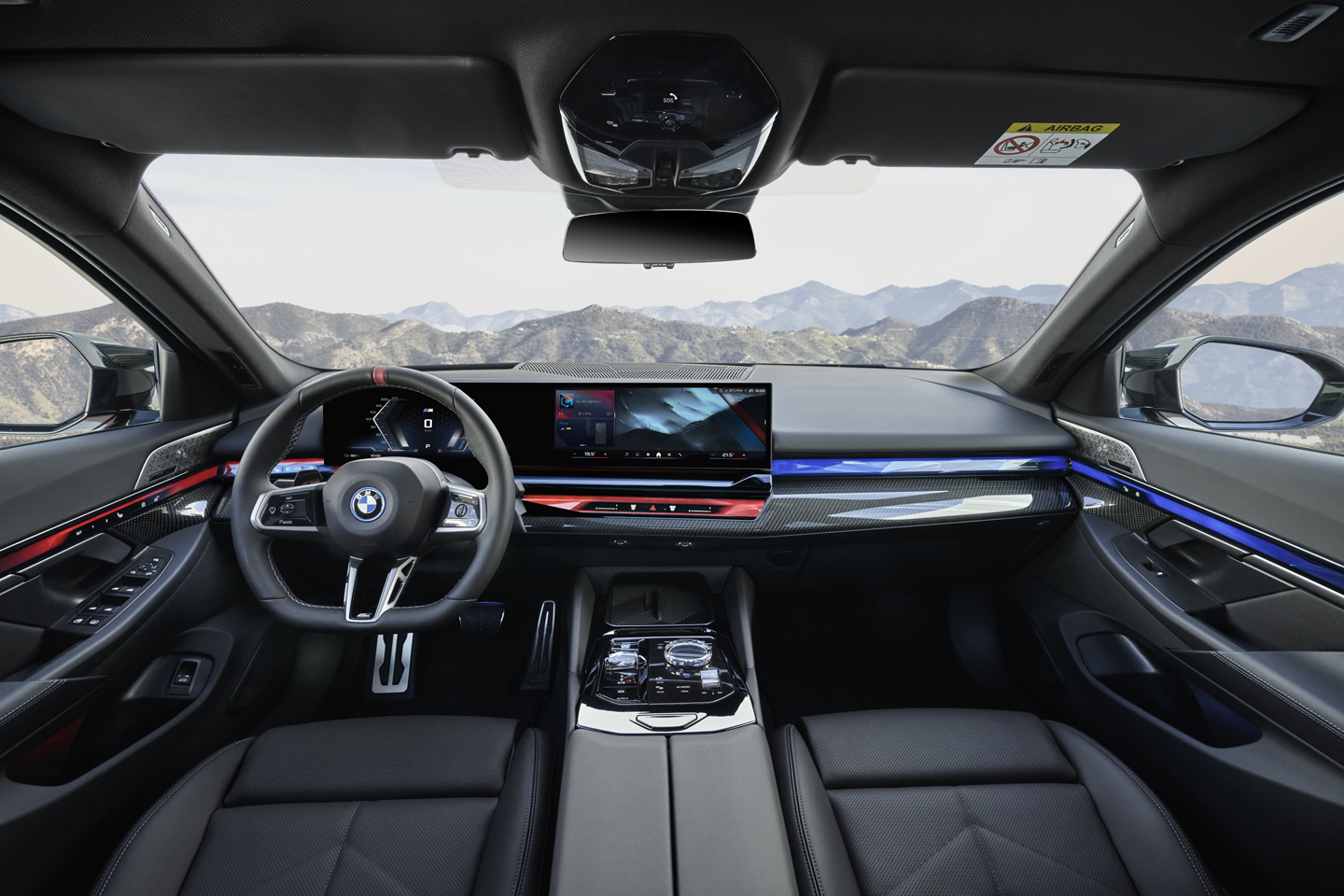
A new BMW 5 Series is always a big deal, but having said that it’s a model that (mostly) transitions gently. There have been seven versions so far, and as a general rule, a 5 Series is a 5 Series is a 5 Series… But now we’re on the verge of the eighth-gen 5 Series, and almost unarguably this is the most significant change of them all. Because some of them aren’t even called a 5, but rather i5. Yes, my friends, this will be the first all-electric BMW 5 Series.
That means there are two bookends to its performance. At one end, there’s the new i5’s electric range. That’s best in rear-wheel-drive eDrive40 form, where it offers up to 361 miles – slightly less than an EQE 300 (388 miles) but still pretty useful. Put it this way, if you started from London heading north, you’d reach Berwick-upon-Tweed, on the Scottish border, with some miles to spare. Don’t fancy Scotland? Well, venture in a south-easterly direction and you could one-stop it to Luxembourg – as long as you avoid any standing starts that test its 0-62mph claim of six seconds.
At the other end of the performance spectrum is speed and power. So far, the fastest 5 Series we’ve seen is the M5 CS, which made 635hp from its antediluvian but oh-so charming twin-turbo V8. That was good enough for 0-62mph in three seconds dead. To be fair, that car was – and is – mega. So mega that the current fastest i5 can’t beat it. In dual motor M60 form it has ‘only’ 601hp, and with a big battery to lug about it does 0-62mph in 3.8 seconds. Still, not exactly slow, is it? Nor is its 143mph Vmax, and the M60 has up to 320 miles in it, if driven carefully.


The M60’s front and rear power split is 261hp and 340hp, while system torque is 586lb ft. That increases to 605lb ft when the driver activates either M Sport Boost or M Launch Control. M Sport Boost also appears on the eDrive40, and it’s activated by holding the paddle on the left side of the steering wheel for an eighth of a second. Along with maximum acceleration, this also changes the drive sound to the one you’ve assigned – it seems BMW is still intent on making almost everything configurable, then.
Both electric versions use the same battery – it has a useable 81.2kWh stored in four modules, each containing 72 cells. To make it more efficient, it comes with a heat pump to manage the battery and motor temperature, as well as the interior climate. Waste heat from the motors can also be used to regulate the battery’s condition. Adaptive regenerative braking is available, which manages the regen using GPS data as well as looking at the distance to the car in front. There are three further fixed modes for the braking, with the lowest a coasting mode.
For maximum range there’s an efficiency optimiser called My Mode Efficient. This can be used when setting out on a long trip to increase the range by up to 25 per cent. It limits elements such as motor power and air conditioning. Another setting, called Max Range mode, is for extreme range situations – the cold sweat moments when you pitch up at a charger only to find the screen says Sorry, I’m on strike today. Max Range mode limits a lot more of the electrical drains and the top speed to 56mph, so (hopefully) you can eek out enough miles to reach the next charging station.

If the charger is powerful enough, the i5 will charge at up to 205kW DC, which means you could be back up and running with a 10-80 per cent boost in 30 minutes. The first 10 minutes of that will add up to 97 miles.
There will of course be a petrol-hybrid M5 arriving later in the model’s life, which we know will run a version of the drivetrain from the BMW XM. And for the rest of us who aren’t yet ready to go electric and have a more sensible budget, there’s still ICE available, too. That’s because the trusty 520i badge is back, for now, producing 190hp. But with a little help from 48-volt mild hybrid assistance, the total power available is a handy 208hp. That means a 7.5-second 0-62mph dash is achievable as well as a combined 49.6mpg. The engine is a modular engine that uses the Miller combustion process to shorten the opening times of the intake valves. The latest version of BMW’s Valvetronic also reduces frictional losses on overrun.
The new 5 Series uses a double wishbone setup at the front with the now familiar five-link arrangement at the rear. Conventional, then, but there’s been a lot of development to reduce NVH from the suspension. Noise suppression was also a target for the i5 models, with work to isolate the motors in both the RWD and AWD versions. Rear-wheel steering is also available, turning the rear wheels up to 2.5 degrees to aid high-speed stability and low-speed manoeuvrability – the new car’s turning circle is 11.7 metres with it fitted.


Stiffer M Sport suspension is standard, which lowers the car by 8mm. i5 models come with bespoke twin-piston dampers that provide additional damping to control the battery weight, and they have self-levelling suspension at the rear fitted as standard. Adaptive damping is an option on all models and active anti-roll bars are available on the M60. As ever, wheels are getting bigger and bigger, and the new 5 Series is available with diameters from 19 to 21 inches.
The familiar suite of in-car tech will feature – the sort we’ve seen on new models such as the XM and i7. That includes over-the-air updates, natural speech voice recognition and BMW’s latest iDrive infotainment with curved display. There are also AI elements. For example, AI will monitor the car’s tyre wear as well as pressure and also proactively offer service solutions by ‘recognising the vehicle’s service needs’.
The 520i kicks off the range at £49,850. The i5 eDrive40 starts from £73,200 and the M60 a rather heady £96,840. That said, the equivalent Mercedes-AMG EQE 53 is 114,750, so it’s heavily undercutting its most (traditionally) obvious direct rival. And the rivalry kicks off when first deliveries begin in October 2023.
#601hp #M60 #tops #allnew #BMW #Series #range













